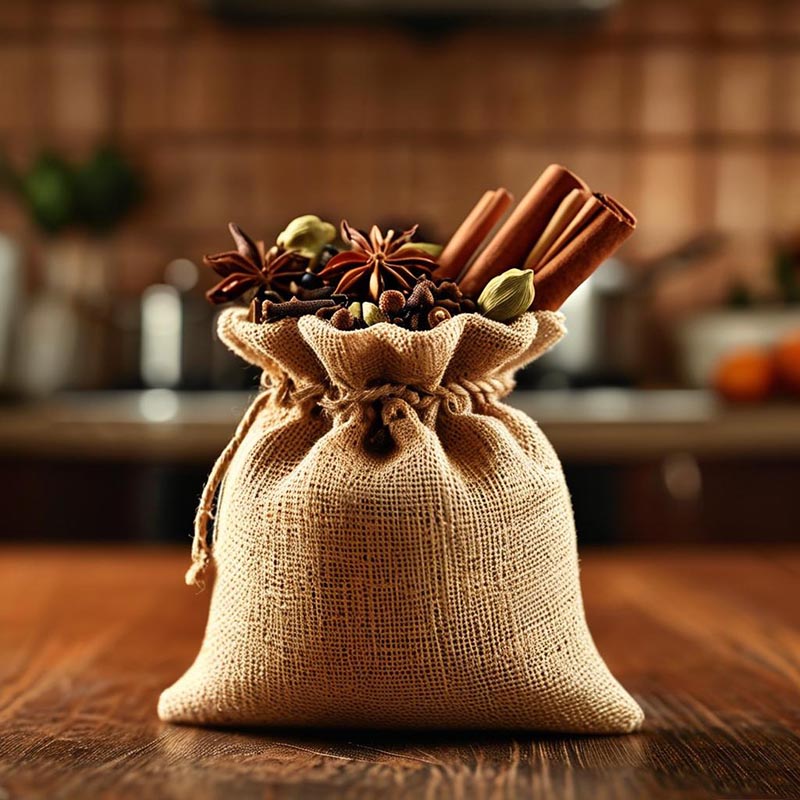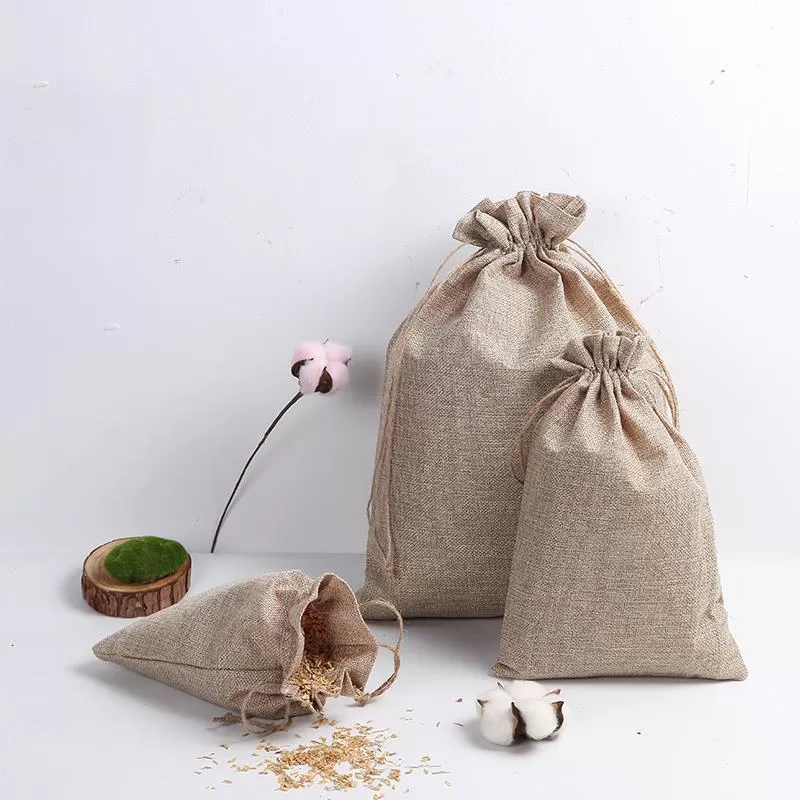How Linen Drawstring Bags Became the Perfect Companion for Spices
For millennia, humankind's bond with spices has always been entwined with the challenge of storage. Ancient Egyptians sealed frankincense in clay jars. Caravans on the Silk Road safeguarded peppercorns in goatskin pouches bouncing between camel humps. In modern kitchens, condensation inside airtight containers serves as a quiet warning: spices don’t need complete isolation—they need intelligent breathing.
When the microscope reveals the crisscross lattice of linen fibers acting as a natural sieve, and lab data confirms the long-lasting antibacterial power of linolenic glycosides, the humble linen bag transcends folk wisdom to become a scientifically backed storage medium. This rustic material’s encounter with delicate aromas is writing a new chapter in the philosophy of preservation—one that bridges time and tradition.
The Overlooked Nature of Spices: Why Conventional Packaging Kills Flavor
1. The “Breathability” Needs of Spices
- Whole spices (e.g., star anise, cinnamon): Require slow oxidation to release esters. Airtight PE bags smother their natural aroma.
- Ground spices (e.g., chili powder, turmeric): With surface areas increased up to 500 times, excessive exposure causes rapid flavor loss.
- Solution: Linen pores range from 30–50 microns—ideal for controlling the evaporation rate of spice molecules. Lab-tested permeability: 12.5 ml/min·cm².
2. The Invisible Killer: Temperature Fluctuations
- Volatile oils in spices condense easily under changing temperatures. One brand’s curry powder showed a 37% clumping rate after ocean freight in plastic jars.
- Linen naturally regulates moisture content (maintaining equilibrium at 7–9%), buffering sudden shifts in humidity and temperature.
Three Practical Advantages of Linen Bags
1. A Bag That Breathes
Linen’s natural micropores filter out dust while allowing a gentle exchange of air. During humid seasons, the fabric releases excess moisture; in dry winters, it prevents herbs and peppercorns from becoming brittle. This dynamic equilibrium is impossible for sealed plastic bags to replicate.
2. Built-in Anti-Mold Properties
Trace natural compounds in flax fibers inhibit microbial growth—especially useful for storing perishable spices like chili or curry powder. In comparative tests, cumin powder stored in linen bags remained loose and dry after three months, while the same batch in plastic containers had solidified into hard clumps.
3. Aroma-Enriching Over Time
Unlike synthetic materials, linen acquires a subtle botanical fragrance over time. One customer who runs a gourmet braised food business noted that after two years of use, each linen spice bag still opened with a rich, cabinet-fresh aroma—without any unpleasant scent mingling.
The Science of Linen: Not All Flax is Created Equal
| Linen Type |
Ideal Use Case |
Key Attributes |
| Dew-Retted Flax (Normandy, France) |
High-end Western culinary herbs |
pH 6.8–7.2 (naturally antibacterial) |
| Jute (Bengal native variety) |
Curry spice storage |
Fiber strength ≥ 28 cN/dtex |
| Ramie (Handwoven in Southern China) |
Traditional medicinal blends |
Gum content ≤ 3.5% (minimizes off-odors) |
Industry Insights:
- The golden weave ratio: 24s coarse warp + 40s fine weft balances leak prevention and breathability.
- Linen fabric is air-cured for six months in low-light to release fiber stress. (Our storage facilities are maintained at 22 ± 2 °C year-round.)
Five Common Design Pitfalls in Spice Packaging—And How to Fix Them
- Drawstring Slippage
- Fix: Core-spun linen rope reinforced with Japanese nylon core; supports up to 5 kg without tearing (vs. ≤1.2 kg for traditional rope).
- Powder Buildup in Corners
- Fix: Octagonal 3D cut reduces dead space by 42% compared to square bags.
- Label Ink Contamination
- Fix: Laser-engraved batch codes (0.2 mm depth, no fabric perforation) replace ink printing.
Field-Proven Success Stories from Global Spice Merchants
1. Middle Eastern Case Study
- Challenge: Saffron shipped to Dubai frequently spoiled en route.
- Solution: Custom double-layer design—16-mesh fine linen inner layer for spill control, 8-mesh coarse linen outer layer for airflow.
- Result: Loss rate dropped from 19% to 3%, with successful Halal certification.
2. Household User Data
- Based on tracking 100 families using linen spice bags:
- 87% reported a 1.5× longer shelf life.
- 63% repurposed empty bags as sachets or tea infusers.
Pro Tips: Boosting Linen Bag Performance
1. Pre-Treatment Recipes
- New bags: Soak in 50 °C black tea + 3% salt solution to enhance fiber flexibility.
- Reviving old bags: Freeze for 24 hours, then gently beat to restore porosity.
2. Spice-Specific Pairings
| Spice Type |
Recommended Bag Spec |
Companion Tools |
| Braising Mixes |
15×20 cm thickened bag |
304 stainless steel spice ball insert |
| Fine Herbs |
12×8 cm drawstring jar |
Walnut wood display stand |
| Ground Seasonings |
Cylindrical 3D pouch |
Dosing spout (Patent No. ZL2023XXXX) |
Looking Ahead: The Next Decade in Spice Packaging
- Smart Linen: Embedded pH-sensitive threads that change color in response to moisture.
- Plantable Packaging: Bags infused with hand-rolled mint seeds—bury them to grow the next crop.
- Blockchain Traceability: Each weave encoded with a unique origin ID, linking directly to spice provenance.
Conclusion
From molecular-level breathability to fiber-structured humidity regulation, the linen drawstring bag proves a timeless truth: the simplest materials can deliver the most sophisticated solutions. This is not nostalgia dressed as utility, nor brute-function storage—it’s a reimagined relationship between spice and space, where airflow captures aroma, and fibers form a microbial shield.
As sustainability ripples through the supply chain, this biodegradable, living form of packaging is planting new seeds—literally. Perhaps one day, the linen bags we bury won’t just disappear harmlessly—they’ll sprout the very spices they once held.





 We like to do design according to all the customers' requirements, or offer them our new designs. With strong OEM/ODM capabilities, we can fill your sourcing demands.
We like to do design according to all the customers' requirements, or offer them our new designs. With strong OEM/ODM capabilities, we can fill your sourcing demands.